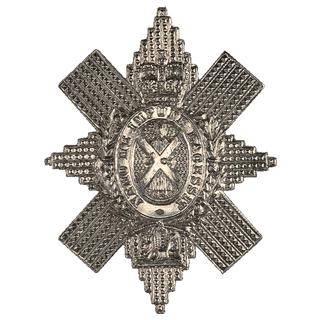
In the wake of the 1715 Scottish rebellion, companies of trustworthy Highlanders were raised from loyal clans. They became known as the Black Watch for the watch they kept on the Highlands and from their dark government tartan. In 1739 King George II authorised the companies be formed into a regiment of foot, "the men to be natives of that country, and none other to be taken". That same year they held their first regimental parade on the banks of the River Tay at Aberfeldy.
The Regiment's first blooding occurred in Flanders in 1745, in the war of Jenkin's Ear at the Battle of Fontenoy, where the French dubbed them "Highland Furies". In 1751 the Regiment was numbered the 42nd, the Gallant Forty Two. Seven years later the title "Royal" was granted and it became the 42nd Royal Highland Regiment.
The Regiment then saw action in the Americas, most notably in Ticonderoga and the Heights of Abraham, and acquired its present badge and motto "Nemo me impune lacessit" which refers to the Thistle and means "nobody provokes me without being hurt". In 1759 the red hackle, seen in the feather bonnets and worn by all ranks of the Black Watch, was first presented at Royston, in Hertfordshire. During the Napoleonic Wars the Regiment fought at the Battle of Alexandria (hence the Sphinx and the word Egypt on its colours), in the Peninsula, including Corruna, and finally at Quatre Bras and Waterloo. Its 19th century battle honours include Alma and Lucknow, and in the 1860s Queen Victoria authorised the addition of the name "the Black Watch" to the official title of the 42nd Royal Highlanders, a title which has become known throughout the world.
In World War I 11 Battalions of the Regiment fought in France and Flanders, Macedonia, Mesopotamia and Palestine. Her Majesty Queen Elizabeth, the Queen Mother, Colonel in Chief of the Black Watch since 1937, had two brothers and a first cousin in the 5th Battalion, another brother killed in 1915 with the 8th and a cousin killed serving with 4/5th. Armistice Day found the Regiment advancing across the very field at Fontenoy where the Watch had fought 173 years before. The French commemorated the stalwart assistance given to them in Champagne in 1918 by erecting a cairn on the spot where fell the body of the Black Watch soldier who advanced the furthest - "Here shall flourish for ever the glorious thistle of Scotland among the roses of France".
In World War II the Regiment was present at Dunkirk and fought at Crete, Tobruk, El Alamein, Sicily, Normandy, Ardennes and Burma. Indeed, its five Battalions saw service in every major theatre of war except Norway and Malaya.
Its long association with Perth, Scotland, is retained by maintaining at Balhousie Castle its Headquarters and Regimental Museum. More recently the Battalion served in Hong Kong between January 1993 and August 1994 before returning to the United Kingdom and undertaking a tour of West Belfast in Northern Ireland. In July 1996 the Battalion returned home to Scotland and is currently stationed in Fort George in Inverness. In February 1997 they became the last UK infantry Battalion to serve in Hong Kong.

The Queen Mother inspecting the 1st Batallion.
Another site about the Black Watch may be found here.